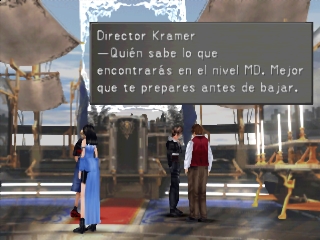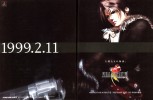Quite possibly the most anticipated game of 1999, Final Fantasy VIII continues Square Soft's best selling RPG series. The story follows Squall Leonhart, a serious and reserved gunblade-toting soldier in the special combat unit known as SeeD, and his role in the war against the hostile Galbadians. (Or so it would appear.) Never much for working with others, Squall's journey will introduce him to a variety of new people, some he'll call friends -- others he won't.
Of the characters he'll meet, no one will affect Squall's outlook on life more than Rinoa Heartilly, a beautiful young woman who teaches him the meaning of love. Also of note, Laguna Loire represents the game's most mysterious character, an ex-soldier turned journalist who appears to Squall in his dreams. Meanwhile, SeeD candidate Seifer Almasy admires Squall's abilities but sees him as an arch-rival.
Though it bears the Final Fantasy moniker, several differences from previous installments can be found in Final Fantasy VIII, most obviously the overall look. The outlandishly deformed designs composing the likes of Cloud Strife and Barret Wallace (from Final Fantasy VII) have been replaced with a more realistic-looking band of heroes and villains.
Also new to Final Fantasy VIII is the Junction System for magical use. Guardian Forces (GF)s such as Ifrit and Shiva, gods and goddesses who allowed previous Final Fantasy characters to use their powers through Materia, are still available and must be obtained in order to utilize certain features of the Junction System. In order to earn possession of a GF, the force itself must be defeated or "drawn" from a boss monster. Other less predictable methods can be used as well. Once a character has obtained a GF, he or she can summon it during a battle, unleashing its power and then proceeding to draw magical abilities from enemies. GFs grow stronger with each battle and will eventually bestow special abilities to the character who junctions it.
Unlike other Final Fantasy games (and most role-playing games for that matter), magic points are not the limiting factor for casting spells in Final Fantasy VIII. Rather, drawn spells are quantitative; each opponent you face has a type of magic that can be drawn, or taken. For instance, if a character has eight spells of one type and then casts one, he or she is left with seven of that type until more are drawn. Spells can also be junctioned to improve a character's vital statistics such as hit points, offense and defense. For example, junctioning a spell like Full-Life to hit points will make them increase dramatically, especially if you have a lot of them stocked. Similarly, Fire junctioned to attack means bad news to ice monsters just as junctioning Thunder to defense won't make your typical Blitz (a type of thunder monster) very effective. (In such cases, their attacks might even heal you instead!)
Some RPG fans might be alarmed to learn that characters stick with their weapons throughout the course of the entire game. However, by reading the Weapons Monthly magazine and visiting a junk shop, weapons can be upgraded -- but not how you might suspect. Though a fee is involved, it is minimal. The challenge comes in attaining the rare items necessary for the upgrades, which can usually be gained by defeating or stealing from powerful monsters. Incidentally, money is not earned after defeating a monster but rather through Squall's SeeD salary, determined by his performance in field and written tests.
As with most RPGs, experience points (for both the characters and Guardian Forces) are gained after defeating monsters, resulting in higher levels of experience as more are attained. However, as the characters gain experience, so do the monsters. In other words, the level seven Bite Bugs you fight at the beginning of the game will still be just as challenging 93 levels later.
Unlike Final Fantasy VII, which featured many mini-games, few are found in Final Fantasy VIII. However, "Triple Triad" (a card game played with a similar mindset as dominos) can play a major role in your inventory later in the adventure. Each game, available to play as long as there are people around to converse with, pits a party member and non-player character (NPC) against one another with the cards they have in their possession. Strategic placement of cards will earn a player victory and the right to choose one or more of the loser's cards for his or her own collection. "Local rules" may apply, so don't expect the same game every time. Besides through beating a NPC, cards can be obtained by defeating enemies or by utilizing the "card" command during battle, in which a GF must be junctioned to use. Ultimately, the cards can be refined into rare items and spells that help out tremendously in your quest.
Though there may be a few differences, many of the popular features of the franchise return in Final Fantasy VIII. First, Limit Breaks can be enabled at critical moments unleashing a unique and powerful attack from a character. There are also various battle abnormalities inflicted by opponents (i.e., sleep, curse, berserk, confuse and slow), item shops and a variety of vehicles to operate for faster movement on the world map.
And what would a Final Fantasy game be without a few Chocobos? In addition to utilizing their services in the game, fans of the burden-bearing birds who also happen to own a PocketStation (as of the game's release, only available in Japan) have the opportunity to play "Chocobo World." This simple-looking yet epic journey involves a Chocobo named Boco and Final Fantasy favorite Mog.
Manufacturer's description:
A member of an elite military team, Squall is forced into a conflict beyond imagination. To survive, he must contend with a desperate rival, a powerful sorceress, and his own mysterious dreams.
Realistic, detailed characters and background graphics enhanced by a breathtaking musical score
An epic story based on the theme of love, set in a massive new world
New Junction System allows characters to be customized with powerful magic spells drawn from enemies
Nearly an hour of stunning motion-captured CG cinemas seamlessly integrated into gameplay
Features:
- Third person perspective
- 2D graphics
- SCI-FI, Futuristic & Fantasy themes.
|
|



































 - Disc Cover
- Disc Cover






